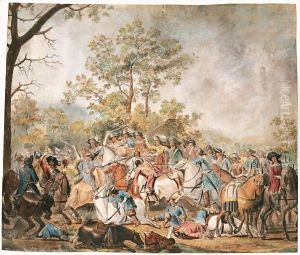Barent Van Calraet Paintings
Barent van Calraet, also known as Barent van Kalraet, was a Dutch Golden Age painter born in 1649 in Dordrecht, the Netherlands. Not to be confused with Abraham van Calraet, who was often incorrectly credited for Barent's works in the past due to the similarity of their monogram, B.v.C. Barent was primarily known for his tranquil portrayals of horses in stables and landscapes, although he also painted still lifes and historical subjects.
Van Calraet was likely a pupil of Aelbert Cuyp or at least heavily influenced by him, as his style closely resembles that of Cuyp’s work. This is evident in his use of light and his sensitive rendering of atmospheric effects in his landscapes. Like many artists of his time, Van Calraet’s work reflects the great appreciation for the Dutch countryside and the popular practice of keeping horses.
Despite his clear talent and the quality of his paintings, Van Calraet did not achieve significant fame during his lifetime compared to other artists of the Dutch Golden Age. His works were sometimes mistakenly attributed to Cuyp, which contributed to his relative obscurity. It was not until much later that art historians began to correctly attribute and recognize his works.
Barent van Calraet's paintings are characterized by their serene and pastoral quality, displaying an adeptness with both animals and landscapes. His attention to detail and ability to capture the essence of the Dutch countryside provide a valuable glimpse into the rural life of the 17th century. The muted palette and the gentle interplay of light and shadow in his works contribute to a sense of calm and timelessness.
Van Calraet continued to paint throughout his life, contributing to the rich tapestry of Dutch art history. He passed away in 1722 in Amsterdam. Today, his works are held in various collections and museums, appreciated for their contribution to the Dutch tradition of animal and landscape painting.
